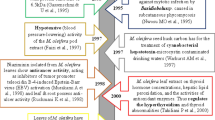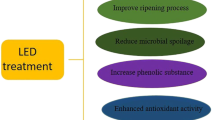Abstract
The dissipation, residues, and risks of 2,4-dicholrophenoxyacetic acid (2,4-d) in citrus under field condition were investigated based on a simple ultra-performance LC (UPLC)-MS/MS method. The results indicated that the residue level of 2,4-d in citrus did not degrade gradually with sampling time under field condition. At pre-harvest intervals (PHI) of 20–40 days, 2,4-d residues were 0.021–0.269 mg/kg in citrus flesh, 0.028–0.337 mg/kg in whole citrus, and 0.028–0.376 mg/kg in citrus peel, all bellow the China maximum residue limit in citrus (1 mg/kg). Risks of 2,4-d were assessed by calculation of risk quotient, and the results revealed no significant health risks after consumption of citrus.



Similar content being viewed by others
References
Abd-Alrahman, S. H., Almaz, M. M., & Osama, I. A. (2012). Determination of degradation rate of acaricide fenpyroximate in apple, citrus, and grape by HPLC-DAD. Food Analytical Methods, 5(2), 306–311.
Aksakala, O., Aygun Erturka, F. A., Sunara, S., Bozarib, S., & Agara, G. (2013). Assessment of genotoxic effects of 2,4-dichlorophenoxyacetic acid on maize by using RAPD analysis. Industrial Crops and Products, 42, 552–557.
Anastassiades, M., & Schwack, W. (1998). Analysis of carbendazim, benomyl, thiophanate methyl and 2,4-dichlorophenoxyacetic acid in fruits and vegetables after supercritical fluid extraction. Journal of Chromatography A, 825(01), 45–54.
Aprea, C., Sciarra, G., Bozzi, N., & Lunghini, L. (2006). Analysis of 2,4-dichlorophenoxyacetic acid and 2-methyl-4-chloro-phenoxyacetic acid in human urine. Pesticide protocols, 19, 91–103.
Charlton, A. J., Stuckey, V., & Sykes, M. D. (2009). Determination of the phenoxyacid herbicides MCPA, mecoprop and 2,4-d in kidney tissue using liquid chromatography with electrospray tandem mass spectrometry. Bulletin of Environmental Contamination and Toxicology, 82(6), 711–715.
Chen, H., Zhang, Z. X., Zhang, G. M., Guo, X. F., Zhang, H. S., & Wang, H. (2010). Liquid chromatographic determination of endogenous phytohormones in vegetable samples based on chemical derivatization with 6-oxy(acetylpiperazine) fluorescein. Journal of Agricultural and Food Chemistry, 58(8), 4560–4564.
Chen, W. J., Jiao, B. N., Su, X. S., Zhao, Q. Y., Qin, D. M., & Wang, C. Q. (2013). Dissipation and residue of forchlorfenuron in citrus fruits. Bulletin of Environmental Contamination and Toxicology, 90(6), 756–760.
Chuang, J. C., Van Emon, J. M., Durnford, J., & Thomas, K. (2005). Development and evaluation of an enzyme-linked immunosorbent assay (ELISA) method for the measurement of 2,4-dichlorophenoxyacetic acid in human urine. Talanta, 67(3), 658–666.
de Amarante, O. P., Brito, N. M., Dos Santos, T. C., Nunes, G. S., & Ribeiro, M. L. (2003). Determination of 2,4-dichlorophenoxyacetic acid and its major transformation product in soil samples by liquid chromatographic analysis. Talanta, 60(1), 115–121.
Fu, F. F., Xiao, L. X., Wang, W., Xu, X. Q., Xu, L. J., Qi, G. M., & Chen, G. N. (2009). Study on the degradation of 2,4-dichlorophenoxyacetic acid (2,4-d) and 2-methyl-4-chloro-phenoxyacetic sodium (MCPA sodium) in natural agriculture-soils of Fuzhou, China using capillary electrophoresis. Science of the Total Environment, 407(6), 1998–2003.
GB 2763-2014: National food safety standard-MRLs for Pesticides in Food.
He, J., Shen, Y., Wang, D. G., Sun, X., Fan, M. T., & Liu, X. J. (2010). Dissipation and residues of 2,4-d-dimethylammonium in wheat and soil. Bulletin of Environmental Contamination and Toxicology, 85(2), 157–159.
Liu, C. Y., Li, L., Wang, S. L., You, X. W., Jiang, S. R., & Liu, F. M. (2012). Dissipation and residue of 2,4-d isooctyl ester in wheat and soil. Environmental Monitoring Assessment, 184, 4247–4251.
Lodh, S. B., De, S., Mukherjee, S. K., & Bose, A. N. (1963). Storage of mandarin oranges. II. Effects of hormones and wax coatings. Journal of Food Science, 28(5), 519–524.
Oliveira, G. H., & Palermo-Neto, J. (1995). Toxicology of 2,4-dichlorophenoxyacetic acid (2,4-d) and its determination in serum and brain tissue using gas chromatography-electron-capture detection. Journal of Analytical Toxicology, 19(4), 251–255.
Popov, S. A., Chumichkina, Y. A., Shapovalova, E. N., Dmitrienko, S. G., & Zolotov, Y. A. (2011). Preconcentration of 2,4-dichlorophenoxyacetic acid on molecularly imprinted polymers and its subsequent determination by high performance liquid chromatography. Journal of Analytical Chemistry, 66(1), 6–10.
Shin, E. H., Choi, J. H., Abd Ei-Aty, A. M., Khay, S., Kim, S. J., Im, M. H., Kwon, C. H., & Shim, J. H. (2011). Simultaneous determination of three acidic herbicide residues in food crops using HPLC and confirmation via LC-MS/MS. Biomedical Chromatography, 25(1–2), 124–135.
Sun, H. B., Liu, C. Y., Wang, S. W., Liu, Y. P., & Liu, M. J. (2013). Dissipation, residues, and risk assessment of spirodiclofen in citrus. Environmental Monitoring and Assessment, 185(12), 10473–10477.
Vdovenko, M. M., Stepanova, A. S., Eremin, S. A., Van Cuong, N., Uskova, N. A., & Yu Sakharov, I. (2013). Quantification of 2,4-dichlorophenoxyacetic acid in oranges and mandarins by chemiluminescent ELISA. Food Chemistry, 141(2), 865–868.
Vinayaka, A. C., Basheer, S., & Thakur, M. S. (2009). Bioconjugation of CdTe quantum dot for the detection of 2,4-dichlorophenoxyacetic acid by competitive fluoroimmunoassay based biosensor. Biosensors and Bioelectronics, 24(6), 1615–1620.
Wang, C., Qiu, L. H., Zhao, H. Y., Wang, K., & Zhang, H. Y. (2013). Dissipation dynamic and residue distribution of flusilazole in mandarin. Environmental Monitoring and Assessment, 185(11), 9169–9176.
Williams, K. J., James, C. R., Thorpe, S. A., & Reynolds, S. L. (1997). Two analytical methods for the measurement of 2,4-d in oranges: an ELISA screening procedure and a GC-MS confirmatory procedure. Pesticide Science, 50(2), 135–140.
Wittmann, C., Bier, F. F., Eremin, S. A., & Schmid, R. D. (1996). Quantitative analysis of 2,4-dichlorophenoxyacetic acid in water samples by two immunosensing methods. Journal of Agricultural and Food Chemistry, 44(1), 343–350.
Zeljezic, D., & Garaj-Vrhovac, V. (2004). Chromosomal aberrations, micronuclei and nuclear buds induced in human lymphocytes by 2,4-dichlorophenoxyacetic acid pesticide formulation. Toxicology, 200(1), 39–47.
Acknowledgments
This work was supported by Fundamental Research Funds for the Central Universities (No. XDJK2014C025), National Key Technology R&D Program (No. 2009BADB7B04), Natural Science Foundation of Chongqing (No. cstc2013jjB80009), and China Agriculture Research System (No. CARS-27).
Author information
Authors and Affiliations
Corresponding author
Rights and permissions
About this article
Cite this article
Chen, W., Jiao, B., Su, X. et al. Dissipation and residue of 2,4-d in citrus under field condition. Environ Monit Assess 187, 302 (2015). https://doi.org/10.1007/s10661-015-4536-0
Received:
Accepted:
Published:
DOI: https://doi.org/10.1007/s10661-015-4536-0




